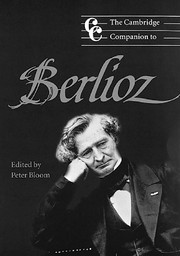Book contents
- Frontmatter
- Introduction: Berlioz on the eve of the bicentenary
- Part I Perspectives
- Part II Principal compositions
- Part III Major writings
- 9 The Mémoires
- 10 The short stories
- 11 The criticism
- 12 The Grand Traité d'instrumentation
- Part IV Execution
- Part V Critical encounters
- Part VI Renown
- Notes
- Bibliography
- Index
12 - The Grand Traité d'instrumentation
from Part III - Major writings
Published online by Cambridge University Press: 28 September 2011
- Frontmatter
- Introduction: Berlioz on the eve of the bicentenary
- Part I Perspectives
- Part II Principal compositions
- Part III Major writings
- 9 The Mémoires
- 10 The short stories
- 11 The criticism
- 12 The Grand Traité d'instrumentation
- Part IV Execution
- Part V Critical encounters
- Part VI Renown
- Notes
- Bibliography
- Index
Summary
When Berlioz's Grand Traité d'instrumentation et d'orchestration modernes appeared at the end of 1843, the work was already known to the readers of the Revue et Gazette musicale de Paris, for it had been published there as “De l'instrumentation” – sixteen feuilletons that appeared from 21 November 1841 to 17 July 1842. In this series, whose “heroes” are the instruments of the orchestra, Berlioz considers that aspect of musical composition in which he had proven to be particularly inventive. The works that he had already written – three symphonies, the Requiem, Benvenuto Cellini – demonstrated the essence of what he brought to the art of instrumentation. In fact his interest in the subject seems to have been born with his very first musical impressions, if we are to believe his early letters, his first articles, and especially his Mémoires.
Beyond his own taste and intuition, what kind of guidance could be found, in the eighteen-twenties, by a young composer who was fascinated by the alchemy of the orchestra? “My two masters [Lesueur and Reicha] taught me absolutely nothing about instrumentation,” writes Berlioz in chapter 13 of the Mémoires:
I regularly attended all the performances at the Opéra. I would take along the score of the work to be played and would follow it during the performance. In this way I began to see how to write for the orchestra, and began to understand something of the timbres and accents as well as of the ranges and mechanisms of most of the instruments. By carefully comparing the effects produced with the means employed to produce them, I was able to see the hidden links between musical expression and the special art of instrumentation. But no one told me that this was the way to do it.
- Type
- Chapter
- Information
- The Cambridge Companion to Berlioz , pp. 164 - 170Publisher: Cambridge University PressPrint publication year: 2000

